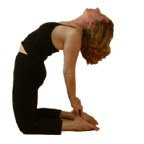 , you can place the palm of your hand flat on the floor on the outside of the bent leg. Some may not be able to place the palm flat on the floor and so they bend their hand with just the fingers on the floor. Over time, this can overstretch the tendons in the hand causing stress and injury. It is better to use the fingertips or to make a fist placing the flat space between the second and third joints on the floor or to use a block.
, you can place the palm of your hand flat on the floor on the outside of the bent leg. Some may not be able to place the palm flat on the floor and so they bend their hand with just the fingers on the floor. Over time, this can overstretch the tendons in the hand causing stress and injury. It is better to use the fingertips or to make a fist placing the flat space between the second and third joints on the floor or to use a block. There is also the challenge that each style or lineage of yoga (Ashtanga, Iyengar, Bikram, etc…) has its own guidance on the specifics of the full expression of a yoga pose. In addition, each teacher through their own personal and teaching experiences may find adaptive nuances that they develop as a teaching preference. For instance, an example is the differences in instruction for a simple squat. One approach is to instruct the student to have his toes and feet in a straight ahead parallel position with heels down. For some students, this works for them anatomically and if they have not had any knee injuries. For many students, it is better to keep their toes and knees in alignment which is easier on their knees and simpler to put the heels down. One of my favorite differences is whether or not your toes are pointed or flexed in a pose.
 In Utthita Hasta Padangusthasana D (standing extended hand to toe pose), I have been trained by my Ashtanga yoga teacher that you can point or flex your toe. However, I have been told by some Ashtanga yoga teachers to point the toe and some to flex the toe. Obviously, there are some different muscles engaging, however, every time I am instructed on a specific direction on pointing or flexing, I find myself smiling and adjusting to the instruction.
In Utthita Hasta Padangusthasana D (standing extended hand to toe pose), I have been trained by my Ashtanga yoga teacher that you can point or flex your toe. However, I have been told by some Ashtanga yoga teachers to point the toe and some to flex the toe. Obviously, there are some different muscles engaging, however, every time I am instructed on a specific direction on pointing or flexing, I find myself smiling and adjusting to the instruction. The full expression of a pose is beautiful to observe and is an expression to help guide the direction of one’s practice. However, for many of us, due to previous injuries, anatomical uniqueness, or age, we may never achieve the full expression of the pose. It’s not the goal to achieve the full expression of a pose, it’s the journey. Learning to understand ourselves, discipline ourselves, and find balance between us and the world are key events in our journey. Uniting our mind, body, and spirit is a learning process and because each of us is unique, our journey will be unique. Better yoga poses come from a practitioner’s growing awareness of themselves. Listen to your internal guidance and make your own recipe.





No comments:
Post a Comment